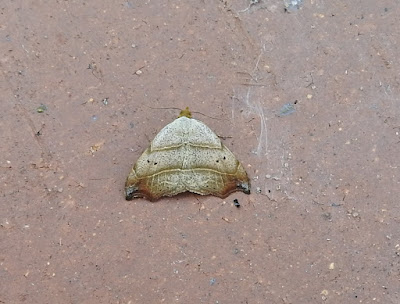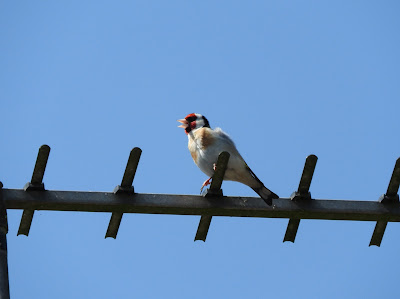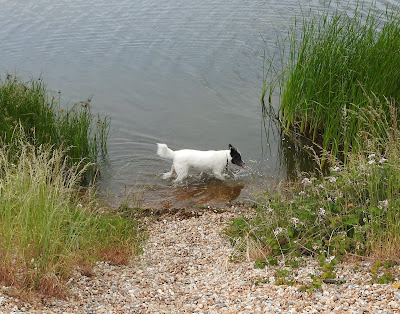Warm, dry and sunny, SW 4 - This morning our Ted walk took us across the arable lands towards Belgar Farm following the line of Dengemarsh sewer. I wanted to check out a couple of pea fields along the way for calling Quail, their preferred field crop, of which there was no sound. Infact, as the wind picked up there was very little activity apart from several Skylarks overhead, a couple of Reed Warblers and Reed Buntings singing from the reed-fringed sewer and a distant Corn Bunting jangling away. Working in the garden this week has produced a trickle of high-calling Mediterranean Gulls over the town, a `kettle` of six Common Buzzards and regular Sparrowhawk sightings. Moth numbers and variety has picked these past muggy nights with a Beautiful Hook-tip the best of the bunch.
Beautiful Hook-tipIn contrast yesterday evening, at Scotney sand pit, I joined Dave S where there was plenty on offer at this temporary and working industrial quarry complete with a myriad of freshwater lagoon and muddy islands, perfect then for hungry waders. Even in land-locked Bedfordshire these sites lured down a few transient waders, but nothing like the numbers dropping in at a coastal location such as this. The only thing is that these sites don`t stay wader-friendly for long; either they get infilled or flood and become a steep-sided lake, so best to enjoy them while you can. However, passage waders included at least 11 Green and one Common Sandpipers, two Common Snipes, a Black-tailed Godwit and a Greenshank (overhead), along with 27 Avocets, four Lapwings, six Oystercatchers (inc a pair with three juveniles), three Little Ringed and two Ringed Plovers. There was also a good supporting cast of 23 Shelducks, 20 Black-headed Gulls,50 Mallards, 10 Tufted Ducks, six Gadwalls, four Teal and two Shovelers. We also noted a Hobby, a Sparrowhawk with prey, two Yellow Wagtails, Sedge and Cetti`s Warblers and several Sand Martins. On the way home the regular Little Owl was on the barn at Hammonds Corner.
Scotney sand pit
Elsewhere this week circuits of Dengemarsh have been fairly samey with all the expected wetland birds including the odd Avocet and Greenshank on the hayfields, along with a few Lapwings and eclipse ducks, Little Egrets, Black-headed Gulls and a Hobby. Kerton quarry has produced several pairs of Oystercatchers and Lapwings with fledged young, while gull and duck numbers are beginning to build as their breeding season comes to an end.






















































